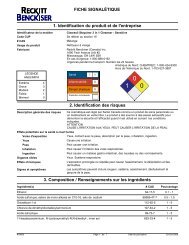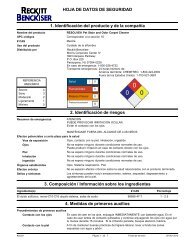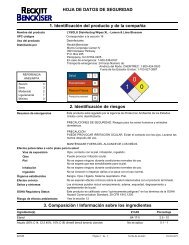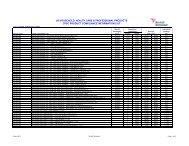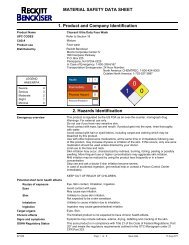MATERIAL SAFETY DATA SHEET 1. Product ... - Reckitt Benckiser
MATERIAL SAFETY DATA SHEET 1. Product ... - Reckitt Benckiser
MATERIAL SAFETY DATA SHEET 1. Product ... - Reckitt Benckiser
Create successful ePaper yourself
Turn your PDF publications into a flip-book with our unique Google optimized e-Paper software.
.<br />
.<br />
.<br />
space<br />
Auto-ignition temperature<br />
space<br />
Viscosity<br />
Not available<br />
Viscous<br />
10. Stability and Reactivity<br />
space<br />
Chemical stability<br />
space<br />
Conditions to avoid<br />
space<br />
Incompatible materials<br />
Stable under recommended storage conditions.<br />
Do not mix with other chemicals.<br />
Reacts violently with alkaline material. This product may react with reducing agents.<br />
Fumes are corrosive to metal.<br />
Bases. Reducing agents.<br />
space<br />
Hazardous decomposition products May include and are not limited to:<br />
space<br />
Possibility of hazardous reactions Hazardous polymerization does not occur.<br />
1<strong>1.</strong> Toxicological Information<br />
space<br />
Acute effects<br />
space<br />
Component analysis - LC50<br />
Ingredient(s)<br />
Alcohols, C12-16, ethoxylated<br />
Ethoxylated aliphatic amines<br />
Hydrogen chloride<br />
space<br />
Component analysis - Oral LD50<br />
Ingredient(s)<br />
Acute LD50: 1350 mg/kg, Rat, Oral<br />
Acute LD50: >2000 mg/kg, Rabbit, Dermal<br />
LC50<br />
Not available<br />
Not available<br />
935 ppm mouse; 3124 mg/l/4h rat<br />
LD50<br />
Alcohols, C12-16, ethoxylated<br />
Ethoxylated aliphatic amines<br />
Hydrogen chloride<br />
space<br />
Effects of acute exposure<br />
space<br />
Eye<br />
Skin<br />
space<br />
Inhalation<br />
space<br />
Ingestion<br />
space<br />
Sensitization<br />
space<br />
Chronic effects<br />
space<br />
Carcinogenicity<br />
1380 mg/kg rat<br />
620 mg/kg rat<br />
900 mg/kg rabbit; 700 mg/kg rat<br />
Causes chemical burns. May cause blindness.<br />
Causes chemical burns.<br />
May cause respiratory tract irritation or chemical burns.<br />
Harmful if swallowed. May cause chemical burns to mouth, throat and stomach.<br />
The finished product is not expected to have chronic health effects.<br />
The finished product is not expected to have chronic health effects.<br />
The finished product is not expected to have chronic health effects.<br />
ACGIH - Threshold Limit Values - Carcinogens<br />
Hydrogen chloride 7647-01-0 A4 - Not Classifiable as a Human Carcinogen<br />
IARC - Group 3 (Not Classifiable)<br />
Hydrogen chloride 7647-01-0 Monograph 54 [1992]<br />
space<br />
Mutagenicity<br />
The finished product is not expected to have chronic health effects.<br />
space<br />
Reproductive effects<br />
space<br />
Teratogenicity<br />
space<br />
Synergistic Materials<br />
space<br />
Ecotoxicity<br />
The finished product is not expected to have chronic health effects.<br />
The finished product is not expected to have chronic health effects.<br />
Not available<br />
12. Ecological Information<br />
Bulk quantities, if spilled, may be toxic to aquatic organisms, fish, birds and mammals.<br />
control and clean up all exterior spills and prevent liquid from entering any streams,<br />
rivers, lakes and all other bodies of water.<br />
Ecotoxicity - Freshwater Fish Species Data<br />
Hydrogen chloride 7647-01-0 96 Hr LC50 Gambusia affinis: 282 mg/L [static]<br />
space<br />
Environmental effects<br />
Not available<br />
space<br />
Aquatic toxicity<br />
space<br />
Persistence / degradability<br />
space<br />
Bioaccumulation / accumulation<br />
Not available<br />
Not available<br />
Not available<br />
#19631 Page 4 of 7 Issue date 30-Oct-2009



